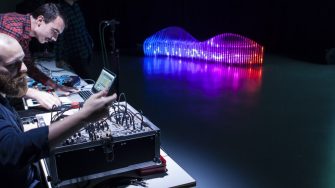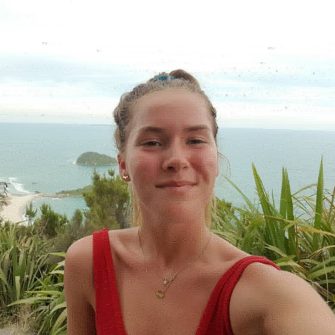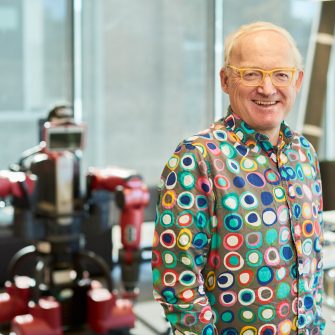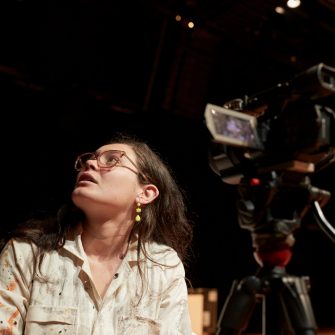Master of Design
- Commencing Terms
- Term 1, 2 & 3
- Duration
- 2 Year(s)
- Delivery Mode
- Face-to-face (includes blended)
- Campus
-
Paddington
- Codes
- Program code 9313
- CRICOS code 082198B
-
Commonwealth Supported Places are available for this program2026 Indicative CSP first year fee
- $10,000*
-
2026 Indicative CSP fee to complete degree
- $19,500*
-
2026 Indicative first year full fee
- $48,500*
-
2026 Indicative full fee to complete degree
- $101,500*

Application closures for 2026
Undergraduate programs for 2026 intakes are closed for New Overseas Student Commencement (NOSC) applications. Applications for postgraduate programs remain open. Find out if this closure applies to you.
- Overview
- Entry requirements
- What will I study?
- Future careers
- Double degrees
- How to apply
- Fees & Scholarships
Overview
This intensive program provides a pathway to advanced industry opportunities, whether you have a background in design and media practice or if you wish to enter these fields from other professional backgrounds. Our degree focuses on integrated and multidisciplinary studios that will underpin the development of professional skills, capabilities and confidence needed for leadership and to dynamically support innovation in freelance, project or design, media and technology business contexts.
Studio-based courses enable you to focus on a specific area of design and digital media practice or put together a suite of courses from across design, material practice and digital media.
Key features
Specialised Studio Practice
Our program allows you to focus your studio-based courses on a specific area of design and digital media or to put together a broad suite of studio courses. Design Electives include Communication Design, Design Leadership, Immersive Design, Interaction and UX Design as well as Materials and Object Design.
Contemporary Design Contexts
Alongside your studio-based courses, you’ll establish a strong foundation in integrated technology, design thinking, experimentation, strategy and communication. You’ll develop a deep and critical understanding of the role design can play in innovation, the economy and solving global challenges.
Why study at UNSW?
- We're ranked =#2 in Australia for art and design (QS World University Rankings by Subject, 2025)
- Adobe Creative Cloud subscription included from the day you start your degree for the duration of your studies
- Be supported by our diverse, open and inclusive Arts, Design & Architecture community.
- Learn through research-informed teaching
- Prioritise career success – UNSW has been awarded Most Employable students for six years in a row (Australian Financial Review (AFR) Top100 Future Leaders Awards, 2020–2025)
- Join our School of Art & Design creative community with a dedicated campus and cutting-edge facilities
- Benefit from strong industry links and partnerships
- Access world-class alumni connections
- Join a global top 20 university (QS World University Rankings, 2024–2026)
- Join a community that’s part of the prestigious Group of Eight (Go8) universities
Entry requirements
Depending on the level and nature of your prior qualifications, admission to the Master of Design has three entry points with different duration and units of credit (UOC) required for completion:
- 2 year program (96 UOC)
A recognised bachelor’s or honours degree (or equivalent qualification) in any field with at least a credit average (65%). Applicants who apply from non-cognate will be admitted on successful assessment of a submitted portfolio. - 1.7 year program (72 UOC)
If you have completed a Bachelor’s degree in a related field with a record of achievement equivalent to a UNSW credit average (65%) you’ll be granted admission into the 1.7 year program. Related Bachelor’s degree programs include Architecture, Design, Landscape Architecture, Interior and Spatial Design, Industrial Design. - 1 year program (48 UOC)
If you have completed an Honours degree in a related field (see above) you’ll be granted admission into the 1 year advanced disciplinary component of program.
If you’re applying without a Bachelor’s degree you may be admitted into the Graduate Certificate of Design by the Program Director on the basis of a portfolio and relevant professional experience. If you complete the requirements for the Graduate Certificate or Graduate Diploma with a record of achievement equivalent to a UNSW credit average (65%) you’re also eligible for admission into the Master’s program with full credit for courses already completed.
Entry score calculator
If you’re uncertain whether you have the equivalent to a UNSW credit average, you can use the UNSW postgraduate entry score calculator to convert and scale other types of grading schemes into a percentage relatable to UNSW entry requirements.
Portfolio Entry to Master of Design
Depending on the level and related nature of your prior design qualifications and experience, you may be required to submit a portfolio. Portfolio submissions must include the following:
- A 10 page A4 digital portfolio of original design work undertaken by the applicant including a critically reflective text.
- A cover letter that explains your interest in studying at UNSW Art & Design, and your interest in the degree. The letter should tell us about your interests, achievements and experience and be no more than 400 words.
- Verified evidence of professional experience in a design or media-related field, in the form of a written statement of service from an employer, client or commissioning agent verifying the position, role, responsibilities, duration and/or project outcomes of employment, service contract or other professional design engagement.
A two page CV that details your experience in, or related to design including contact details for two referees.
Admission pathways
Our suite of programs is designed to build a pathway that increases your capabilities and expands upon your hard-earned experience. We offer the following options to optimise your time while undertaking postgraduate study and provide alternative entry into further qualifications:
- Entry into the Graduate Certificate in Design with a bachelor’s degree in any field. Applicants without a bachelor's degree but with a portfolio of work and professional experience may be admitted on a case-by-case basis.
- Entry into the Graduate Diploma in Design with a bachelor's degree in any field or a Graduate Certificate in Design with at least a credit average grade.
You can articulate into the Master of Design after completing the Graduate Certificate in Design with at least a credit average grade.
English language requirements
You may be asked to provide evidence of your English proficiency to study at UNSW depending on your educational background and citizenship. English language skills are vitally important for coping with lectures, tutorials, assignments and examinations - this is why UNSW requires a minimum English language competency for enrolment.
If you’re completing an Australian Year 12 qualification (e.g. NSW HSC or equivalent), you do not need to provide anything extra to prove your proficiency. Your qualification will be used as evidence of your English proficiency.
If you do need to provide evidence of your English proficiency, this will be indicated in your application. You can prove this by providing evidence that you meet one or more of the following criteria:
- English language tests and university English courses
- Prior study in the medium of English
- Other qualifications
If you need to improve your English skills before you start your degree, UNSW College’s Academic English Programs are for you. The programs are suitable for various English levels and help you prepare for university studies and life in Australia.
For more details, visit the English Language Requirements page.
Depending on the level and nature of your prior qualifications, admission to the Master of Design has three entry points with different duration and units of credit (UOC) required for completion:
- 2 year program (96 UOC)
A recognised bachelor’s or honours degree (or equivalent qualification) in any field with at least a credit average (65%). Applicants who apply from non-cognate will be admitted on successful assessment of a submitted portfolio. - 1.7 year program (72 UOC)
If you have completed a Bachelor’s degree in a related field with a record of achievement equivalent to a UNSW credit average (65%) you’ll be granted admission into the 1.7 year program. Related Bachelor’s degree programs include Architecture, Design, Landscape Architecture, Interior and Spatial Design, Industrial Design. - 1 year program (48 UOC)
If you have completed an Honours degree in a related field (see above) you’ll be granted admission into the 1 year advanced disciplinary component of program.
If you’re applying without a Bachelor’s degree you may be admitted into the Graduate Certificate of Design by the Program Director on the basis of a portfolio and relevant professional experience. If you complete the requirements for the Graduate Certificate or Graduate Diploma with a record of achievement equivalent to a UNSW credit average (65%) you’re also eligible for admission into the Master’s program with full credit for courses already completed.
Entry score calculator
If you’re uncertain whether you have the equivalent to a UNSW credit average, you can use the UNSW postgraduate entry score calculator to convert and scale other types of grading schemes into a percentage relatable to UNSW entry requirements.
Portfolio Entry to Master of Design
Depending on the level and related nature of your prior design qualifications and experience, you may be required to submit a portfolio. Portfolio submissions must include the following:
- A 10 page A4 digital portfolio of original design work undertaken by the applicant including a critically reflective text.
- A cover letter that explains your interest in studying at UNSW Art & Design, and your interest in the degree. The letter should tell us about your interests, achievements and experience and be no more than 400 words.
- Verified evidence of professional experience in a design or media-related field, in the form of a written statement of service from an employer, client or commissioning agent verifying the position, role, responsibilities, duration and/or project outcomes of employment, service contract or other professional design engagement.
A two page CV that details your experience in, or related to design including contact details for two referees.
Admission pathways
Our suite of programs is designed to build a pathway that increases your capabilities and expands upon your hard-earned experience. We offer the following options to optimise your time while undertaking postgraduate study and provide alternative entry into further qualifications:
- Entry into the Graduate Certificate in Design with a bachelor’s degree in any field. Applicants without a bachelor's degree but with a portfolio of work and professional experience may be admitted on a case-by-case basis.
- Entry into the Graduate Diploma in Design with a bachelor's degree in any field or a Graduate Certificate in Design with at least a credit average grade.
You can articulate into the Master of Design after completing the Graduate Certificate in Design with at least a credit average grade.
English language requirements
You may be asked to provide evidence of your English proficiency to study at UNSW depending on whether you are from an English-speaking background or non-English speaking background. English language skills are vitally important for coping with lectures, tutorials, assignments and examinations - this is why UNSW requires a minimum English language competency for enrolment.
If English is not your first language, you’ll need to provide proof of your English proficiency before you can be given an offer to study at UNSW. You can do this by providing evidence that you meet one or more of the following criteria:
- English language tests and university English courses
- Prior study in the medium of English
- Other qualifications
If you need to improve your English skills before you start your degree, UNSW College’s Academic English Programs are for you. The programs are suitable for various English levels and help you prepare for university studies and life in Australia.
For more details, visit the English Language Requirements page.
Check the specific English language requirements for this program
What will I study?
UNSW is introducing a new academic calendar from 2028.
We are moving to a new flex-semester calendar. What does this mean for your studies?
Program structure
The Master of Design offers a customisable structure with flexible entry and exit points and full-time and part-time study options. Depending on the length of your program, you’ll complete the following courses:
2-year program (96 UOC)
- 5 Core courses
- 5 Area of practice courses
- 6 Design in context courses
1.7-year program (72 UOC)
- 4 Core courses
- 3 Area of practice courses
- 5 Design in context courses
1-year program (48 UOC)
- 3 Core courses
- 3 Area of practice courses
- 2 Design in context courses
-
- Communication Design
- Design Leadership
- Immersive Design
- Interaction and UX Design
- Materials and Object Design
- Spatial and Experience Design
Full program structure
Each university year at UNSW has three terms and an optional summer study period.
Some courses need to be studied in your first year, so you’re prepared for courses that can only be studied in later years. You can study full-time or part-time. Depending on how you plan your study load, you can fit two or three courses into a term and one course in a summer term.
The Master of Design has two main components: a core of design studio classes and courses in design contexts and the choice to specialise in a design area of practice.
Core studio courses
In the core studio coursework, you’ll learn to integrate technology, design thinking, experimentation, strategy and communication, with a deep understanding of the role of design in innovation and the global economy. Examples of topics explored through the core studio courses include:
- Art and design research methodologies
- Communication skills
- Design history and theory
- Approaches to design practice
- Design thinking frameworks
Areas of practice
You’ll choose from the following studio-based courses to either focus on a specific area of design and digital media practice or to put together a broad suite of courses:
- Graphic Communication addresses graphic design for paper and print, the screen and broadcast, encompassing contemporary typography, graphic design and cross-cultural communication strategies in designing for different audiences.
- Spatial Experiences engages with the design of processes, services, events and environments, focusing on the quality of the user experience.
- Interaction and User Experience (UX) Design covers visual communication and user experience across graphics, media and emergent interactives.
- Visualisation and Visual Effects focuses on the practices of designing for animation, 3D, sound, film, video, illustration and computing.
- Future Making: Materials and Objects focuses on the making of objects with new materials, digital technologies and craftsmanship. It addresses the integration of technical knowledge and skills with material and contextual understanding. Future making works with ceramics, jewellery, metal, textiles, furniture and lighting.
Below is an example of what you could study in a two-year standard full-time study plan:
First year
- 2 Core studio courses
- 1 Area of practice course
- 1 Area of practice course or postgraduate elective
- 4 Design in context courses
Second year
- 1 Core studio course
- 2 Design studio project courses
- 3 Area of practice courses
- 2 Design in context courses
Future careers
UNSW’s Masters of Design graduates are highly sought after across a broad range of professional design disciplines in media and technology industries, global institutions, major corporations, creative and bespoke agencies.
Potential careers
Masters graduates secure employment in areas including:
Graphics, media and digital design
UX, responsive design and app development
Communications, branding and advertising
Design management and strategy
Social innovation and entrepreneurship
Data visualisation and animation
Creative consultancies, design and media studios, design-led businesses
Object, furniture and lighting design
Film, television, online and mobile production and post-production
Environmental, spatial, interior and architectural design practices
Design for retailing, industry events and expos
Design for exhibitions, galleries and museums
Costume, theatre and events design
Design teaching and academia
Jewellery and wearables design
Textile, fabric and fashion design
Double degrees
The Master of Design can be combined in the following double degree:
How to apply
Applications must be submitted through our Apply Online portal. We encourage you to submit your completed application as early as possible to ensure it will be processed in time for your preferred term. Some high-demand programs and Faculties with limited places may have an earlier application deadline or commencement date. Find out more.
Ready to start your application?
For most international students, applications are submitted via our Apply Online service. We encourage you to submit your completed application as early as possible to ensure it will be processed in time for your preferred term.
Some high-demand programs with limited places, may have an earlier application deadline or may have an earlier commencement date. For details, visit the international admissions information page.
Ready to start your application?
Fees & Scholarships
There are a limited number of Commonwealth Supported Places (CSP) available for this degree/program. Your eligibility to receive a CSP will be automatically assessed when you apply, please ensure you preference the CSP code in UAC to be considered. Start your postgraduate application today with our guide on how to apply.
Please note that eligibility for Commonwealth Supported Places (CSPs) is competitive, with places awarded based on academic merit. To find out more about Commonwealth Supported Places visit Postgraduate Commonwealth Support.
Commonwealth Study Assistance such as Austudy, and Youth Allowance is available for some master’s degrees. For the most up-to-date information and list of degrees visit UNSW Current Student Financial Support.
*The indicative Commonwealth Supported Place (CSP) fees are an estimate based on the relevant student contribution band/s for a Commonwealth Supported Place undertaking a standard full-time load of 48 units of credit per year (1 Equivalent Full Time Student Load/1 EFTSL). To find out more about Commonwealth Supported Places visit Postgraduate Commonwealth Support.
Indicative fees are a guide only and have been calculated based on the typical enrolment patterns of students undertaking the degree/program. The indicative fee listed here is an estimate for tuition only and excludes non-tuition fees and charges. The amount you pay will vary depending on the calendar year of enrolment, the courses you select and whether your study load is more or less than 1 Equivalent Full Time Student Load (48 units of credit (UOC) per year).
You should not rely on indicative fees as fee increases are assessed when required and may exceed the indicative figures listed here. Actual fees are calculated on enrolment. More information on fees can be found at the UNSW fees website.
*Fees are subject to annual review by the University and may increase annually, with the new fees effective from the start of each calendar year. The indicative fees listed here are based on an estimated average and are for tuition only, other fees and charges are not included. The amount you pay will vary depending on the calendar year to enrol, the courses you select and whether your study load is more or less than 1 Equivalent Full Time Student Load (8 courses per year).
Indicative fees are a guide for comparison only based on current conditions and available data. You should not rely on indicative fees. More information on fees can be found at the UNSW fees website.
Indicative fees to complete the program have been calculated based on a percentage increase for every year of the program. Fee increases are assessed annually and may exceed the indicative figures listed here.
Indicative fees to complete the program include tuition plus an estimate of study-related costs of approximately $1,000 per year. To find out more about other costs, visit UNSW International.
Scholarships
At UNSW, we award over $83 million in scholarships each year. We pride ourselves on rewarding excellence and making university accessible to students from all walks of life. Whether you’re a domestic or international student, our range of scholarships, prizes and awards can support your journey.
Progress starts here – at a world-leading university

Top 20 Worldwide
Ranked in the global top 20 for three consecutive years
QS World University Rankings, 2024–2026

Winner of the AFR Most Employable University Award six years in a row
AFR Top100 Future Leaders Awards, 2020–2025

Australia's #1 for Innovation
Highest number of startups and spinouts from university-developed tech
SCOPR report, 2024





